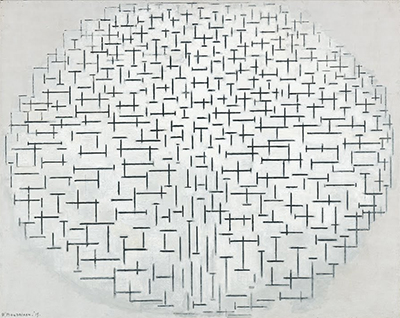Composition 10 in Black and White is a painting from 1915 by Dutch painter, Piet Mondrian. It now forms an important part of the permanent collection of the Kröller-Müller Museum which is based in Otterlo, Netherlands and also features several other artworks by this artist.
This artwork is also sometimes known as Piet and Ocean which reveals a little about what the artist is representing within this piece. In some cases his abstract art would not so much be a representation of anything from reality, but in examples such as this a direct connection can be drawn, even though if often won't be initially obvious. One can see, for example, in his interpretations of views of the city which heralded a number of top-down depictions such as Broadway Boogie Woogie and New York City I. Composition 10 in Black and White is also connected to reality, specifically the shoreline around the artist's home whilst living in several seaside locations in the Netherlands. Once aware of this, we can see that connection in how the painting is put together. We see a mass across the centre of the painting which is filled with small black lines which regularly intersect each other. The lines are small in length and there is a relative consistency between them. The artist chooses to create this painting entirely in black and white which would have been an important conscious choice for someone who considered colour to be one of the most important elements of any artwork.
Within the work we find Mondrian attempting to formulate an abstraction representation of waves arriving at the shoreline. He would use slightly longer lines within the work to provide the waves themselves, with the shorter lines being used for the more calm sections. This was almost like a visual representation of sound, as you might find on scientific graphs. The overall design is rounded and fits to reach the edges of the canvas, leaving some spaces in each of the four corners. We do know that the artist actually made several study drawings prior to beginning this piece and many often underestimate the amount of preparation which was carried out by abstract artists, forgetting that there was often significant meaning behind the various lines and shapes. He would re-use this artistic style several times across a number of years before then moving on again and continuing to re-invent himself time after time, particularly in his more varied early years. The artist liked to restrict content to right angles at this time, using only horizontal and vertical lines and this was a characteristic to his abstract paintings.
In terms of related paintings, see also Mondrian's Ocean 5 and Composition No II, where he tried out different variations and ideas whilst remaining within the overall approach. He would live specifically in the regions of Domburg and Scheveningen and adored both. He would produce more traditional paintings, relatively speaking, of the landscape and focused on the trees within these healthy natural environments. He also included cityscapes from time to time, though normally would ignore the influence and involvement of man, choosing to focus more on nature itself. This body of work has helped him to retain great popularity within his native Netherlands, even though he later moved abroad and his work from then on would not have the same connection to his own country. Today there has also been a greater effort to explain and display his earlier paintings, allowing us all to better understand the full breadth of his career.




